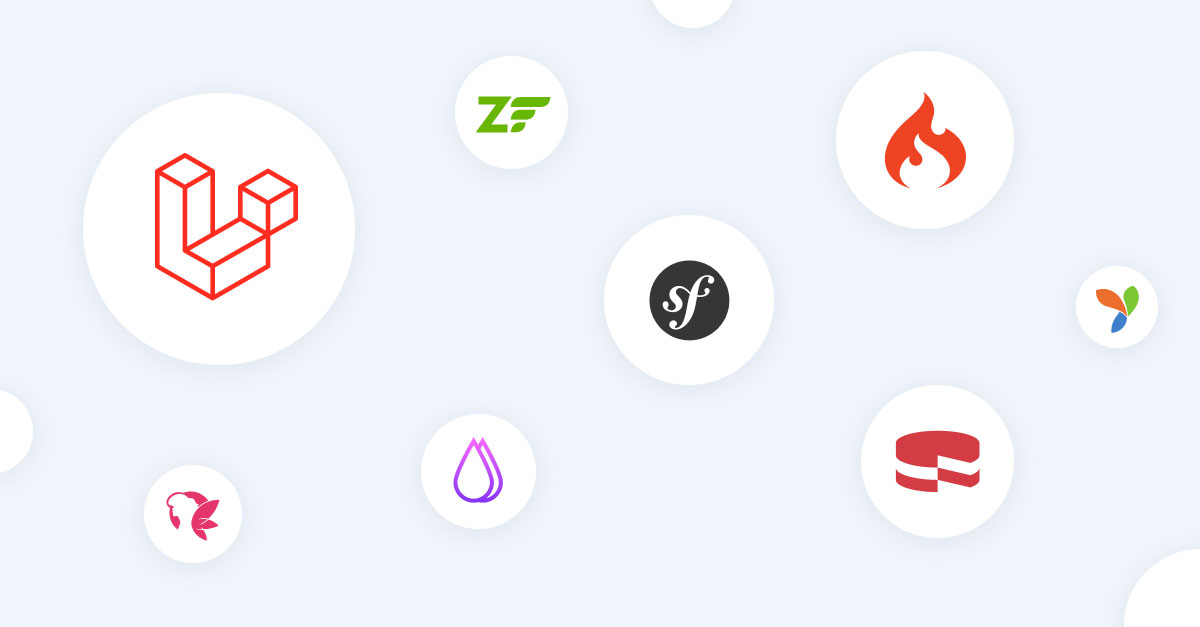17 Popular Java Frameworks for 2023: Pros, cons, and more
Posted Nov 11, 2022 | 23 min. (4724 words)In 2023, Java is still the third most popular programming language in the world. It encompasses a vast ecosystem and more than 9 million Java developers worldwide. Java’s popularity comes down to a few key advantages; it’s a platform-independent language (write once, run anywhere) that follows the object-oriented programming paradigm and is straightforward to understand, write, and debug.
Thanks to the language’s maturity — the latest LTS (long-term support) release is Java 17 — and popularity, there are many ways to create Java applications. While you can always write Java code from scratch, there are also many excellent Java frameworks that allow you to efficiently build web and mobile applications, microservices, and REST APIs that run on the Java Virtual Machine.
In this in-depth guide, we’ll look into 17 popular Java frameworks seen in web development, and list the key pros and cons of each.
What are Java frameworks?
Java frameworks are software libraries created to make building Java applications easier and faster. They consist of pre-written Java code, classes, templates, components, and other structures that you can use as a basis for your application.
The best Java frameworks are well-tested and enforce the use of coding best practices. They let you focus on the business logic of your apps instead of writing basic functionality such as making database connections or handling exceptions.
However, not all Java frameworks serve the same purpose, so choosing one is not just a matter of preference. Some let you create full-stack Java web applications, while others focus on either frontend or backend, and there are also frameworks for specific tasks such as handling database operations. In some cases, you might even want to use more than one framework together, so it’s important to understand how these Java frameworks compare to and integrate with each other.
Why use frameworks?
Creating complex Java applications from scratch takes a lot of time, and adding a framework to your stack simplifies this process. There are many common functionalities that almost every application needs, like data retrieval, security, or privacy. The best Java frameworks include many of these features so that you don’t have to reinvent the wheel every time you start a new project.
They also provide a software architecture that helps you create a well-structured application. As these frameworks are in active development, you can make sure that your Java code is regularly updated and properly tested.
It’s also easier to expand your team, as you can hire developers who are familiar with both Java programming and the framework you use. Most Java frameworks also come with their own ecosystem, including documentation, learning materials, support forums, and social media channels that further facilitate the development process and can prove to be very helpful.
Top 17 Java frameworks
In this collection, you’ll find different types of Java frameworks, including:
- frontend frameworks that let you create the view layer
- ORM (object-relational mapping) and persistence frameworks that allow you to interact with your database
- Java backend frameworks that help with creating microservices and REST APIs
- Java frameworks built on top of other Java frameworks
- … and more
(Note that this article focuses on web development, so this isn’t an exhaustive list. There are other types of Java frameworks as well, such as logging frameworks.)
Without further ado, let’s see the most popular Java frameworks.
Spring Framework: Enterprise-level Java application framework
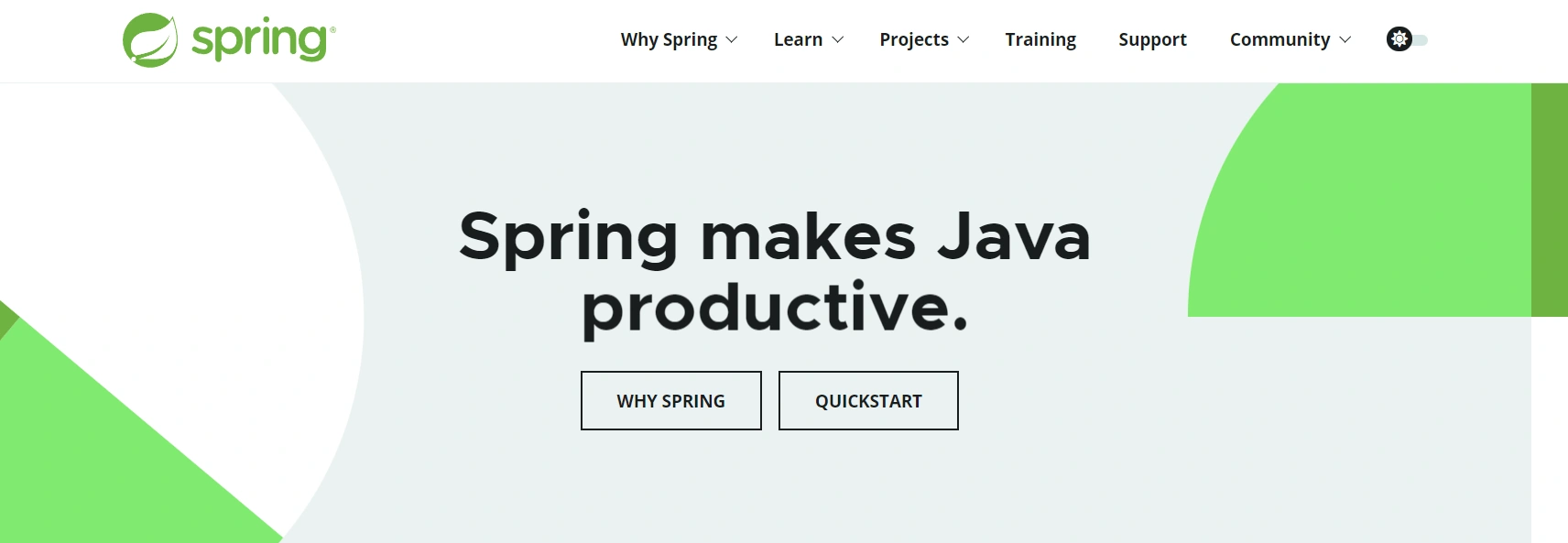
Spring is the most well-known and popular Java framework out there, with a huge ecosystem and an active community around it. It allows you to build enterprise-level Java applications, web services, and microservices.
Spring started out as a dependency injection tool, but over the years has developed into a full-scale application framework. It provides an all-inclusive programming and configuration model that comes with support for generic tasks such as establishing database connections and handling exceptions. Besides Java, you can also use the framework with the Kotlin and Groovy programming languages, both of which run on the Java Virtual Machine.
The Spring framework utilizes the inversion of control (IoC) software design principle, where the framework controls the custom-written code (as opposed to traditional programming where the custom code calls into other libraries that handle generic tasks). As a result, you can create loosely coupled modules for your Spring applications.
While the Spring Framework is excellent for building enterprise-level Java applications, it does have a steep learning curve. This is because it’s a broad framework intended to provide a solution for every possible task within an enterprise-level application, and also supports many different platforms.
Therefore, the configuration, setup, build, and deployment processes all require multiple steps you might not want to deal with, especially if you’re working on a smaller project. Spring Boot (a micro framework that runs on top of the Spring Framework) is a solution for this problem, as it allows you to set up your Spring application faster, with much less configuration.
Pros:
- hugely popular and very stable framework
- flexible configuration
- loose coupling (due to dependency injection)
- easy-to-test applications (due to dependency injection)
- uses POJOs (Plain Old Java Objects)
- extensive documentation
- active community
Cons:
- complexity (steep learning curve)
- need to write a lot of boilerplate code (unless you use Spring Boot)
Struts: MVC framework for enterprise-level Java applications
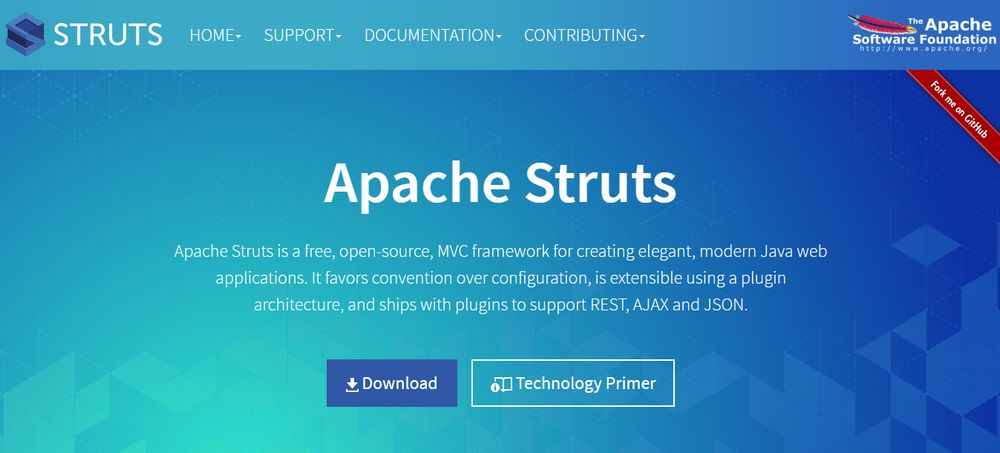
Struts is a full-featured Java web application framework maintained and developed by the Apache Software Foundation. It’s a solid platform with a vast community, often compared to the Spring Framework. Struts allows you to create enterprise-level Java applications that are easy to maintain over time.
It follows the MVC (Model-View-Controller) software design pattern and has a plugin-based architecture. Plugins make it possible to extend the framework to fit different project needs. Struts plugins are basic JAR packages, so they are portable and you can also add them to the classpath of your app. Some plugins are bundled with the framework (JSON plugin, REST plugin, Config Browser plugin, etc.), while you can add others from third-party sources.
You can integrate Struts with other Java frameworks to perform tasks that aren’t built into the platform. For instance, you can use the Spring plugin for dependency injection or the Hibernate plugin for object-relational mapping. Struts also allows you to use different client-side technologies such as Jakarta Server Pages to build the frontend of your application.
However, if you want to create server-side components that can render on the frontend, Struts may not be the best choice for that. Instead, you should look into a framework that has a different architecture such as Tapestry or Wicket (see both below).
Pros:
- stable and mature framework
- convention over configuration
- extensible via plugins
- easy to integrate with other Java frameworks and tools
- supports web technologies (REST, AJAX, JSON)
Cons:
- doesn’t provide any security mechanism (see their security tips that you’ll need to apply by yourself)
Hibernate: Object-relational mapping framework for a better database communication
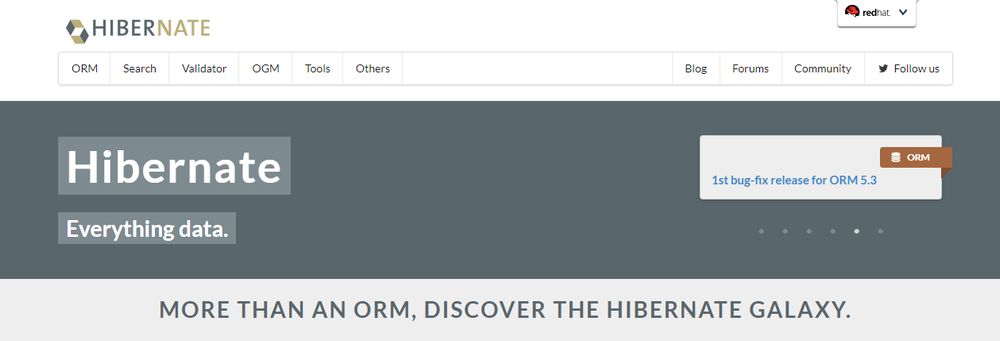
Hibernate is a stable object-relational mapping framework that improves ocommunication between the Java programming language and relational database management systems (RDBMSs).
When you work with object-oriented (OO) languages such as Java, you’ll encounter a problem called Object-Relational Impedance Mismatch (also known as Paradigm Mismatch). OO languages and RDBMSs handle data differently, which can lead to mismatch problems. While OO languages structure data as a hierarchy of objects, relational databases hold the same data in tables. For example, you have a mismatch problem when there are more classes in your object-oriented model than the number of available tables inside your relational database.
Hibernate provides you with a framework that overcomes the mismatch problems of the Java programming language. It aims to achieve persistence, meaning that the data created/used by the application should outlive the process that generated it.
While Hibernate was built for relational databases, its newer versions provide support for NoSQL data stores as well. It also has excellent developer tools such as a mapping editor, a Hibernate console, and a database reverse engineering tool.
Pros:
- object-oriented interface (no need for SQL interfaces)
- enables any class or data structure to be persistent
- supports multiple fetching strategies
- automatic versioning and time stamping
- scales well
- highly extensible and configurable
Cons:
- lower performance for complex queries
- steep learning curve
Apache Wicket: Component-based web application framework for purists
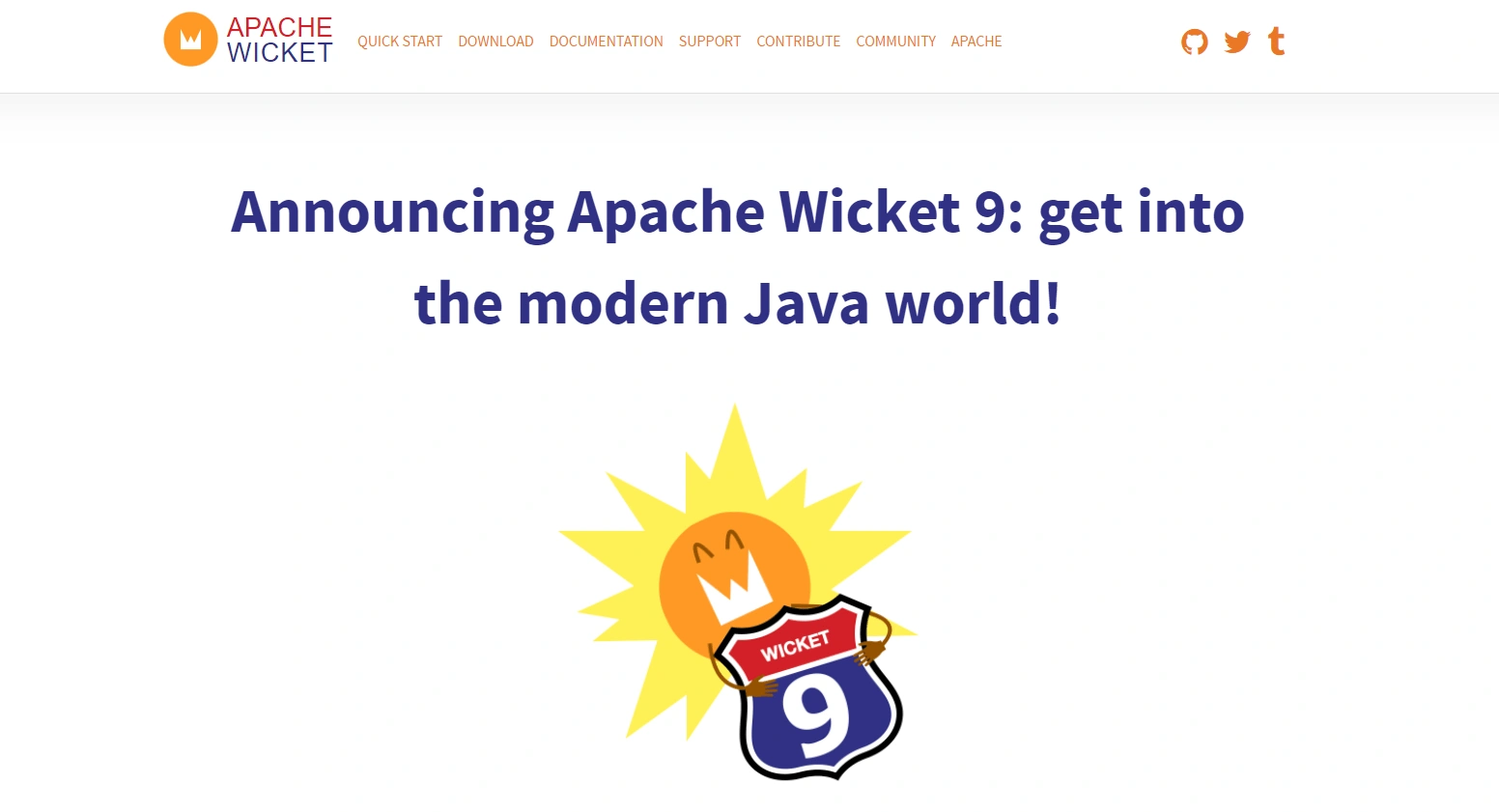
Wicket is a component-based web application framework similar to Jakarta Faces and Tapestry (see later in the article). It allows you to write elegant, user-friendly apps using pure HTML and Java code. The framework is maintained by the Apache Software Foundation similar to Struts and Tapestry.
As Wicket is a component-based framework, apps are made up of reusable pages and components such as images, buttons, links, forms, and others. It uses the POJO data model, so Wicket components are ordinary Java objects. As components are bundled as reusable packages, you can add custom CSS and JavaScript to them.
Wicket lets you internationalize your apps, pages, and components by providing out-of-the-box support for more than 25 languages. Built-in Ajax functionality allows you to update parts of your page in real time without having to write any JavaScript code.
It pays attention to secure URL handling as well. Component paths are session-relative, and URLs don’t reveal any sensitive information. If you want to see how Wicket works in real life, check out the Built with Apache Wicket blog where you can see some nice examples.
Pros:
- separates markup and logic
- no need for JavaScript or XML configuration files
- seamlessly integrates with HTML
- simple state management (components are Java objects that maintain their state)
- you can unit test frontend code
Cons:
- relatively small community; not many tutorials or learning materials
Blade: Simple application framework with a minimal footprint

Blade is a lightweight and high-performance Java framework that allows you to build fast web applications efficiently. The creators aim for users to understand the whole framework in a single day. To achieve this, Blade focuses on simplicity and elegance.
The Blade framework follows the MVC (Model-View-Controller) software design pattern. It has an easy-to-understand design, not depending on any third-party libraries or introducing too many layers. Blade is based on Java 8, and the Netty web server and template engine are built into the framework. It has a minimal footprint; the source code is less than 500 kb in total.
With Blade, you have access to a RESTful-style routing interface and can deploy your app as a basic Maven or Gradle project. Blade has built-in security features too; for instance, it comes with CSRF (Cross-Site Request Forgery) and XSS (Cross-Site Scripting) defense. It’s a versatile framework with support for plugin extensions and webjar resources.
Pros:
- no dependencies
- easy to deploy
- small, lightweight framework
- embedded web server
- template engine support
- flat learning curve
Cons:
- not many tutorials and example projects
- development is less active these days
Dropwizard: Production-ready RESTful web services
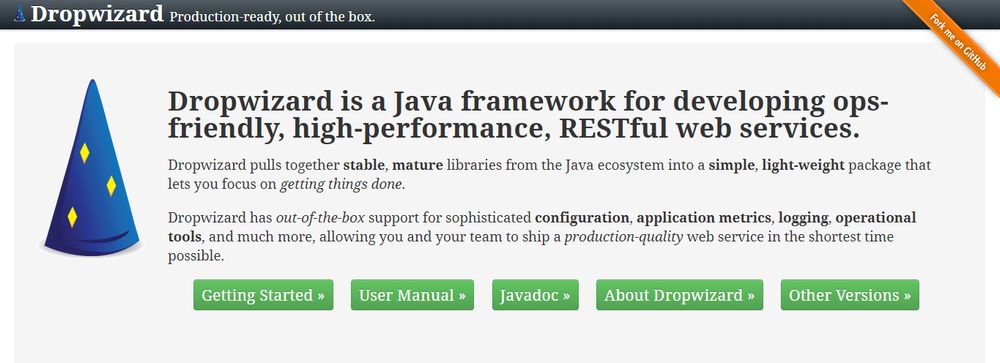
Dropwizard is a high-performance but straightforward Java framework for rapid development of RESTful web services. It’s especially suitable for creating Java microservices.
The Dropwizard framework pulls together several well-established Java libraries to provide you with a fast and distraction-free development platform. It comes with an embedded Jetty server, Google Guava, Logback, Hibernate Validator, Joda Time, and many other popular Java libraries. Dropwizard also contains Jersey which you can use to build RESTful web services and Jackson for processing JSON. You can think of Dropwizard as a separate ecosystem that contains all the dependencies mentioned above, bundled into a single package.
If you choose Dropwizard, you don’t have to spend much time on secondary functionalities such as having to write your code for configuration, metrics, or logging. Instead, you can focus on the primary business logic of your app and achieve maximum productivity. That’s why Dropwizard is often referred to as an operations-friendly Java framework.
Pros:
- simple to set up and get started with
- lightweight
- consists of mature Java libraries
- good conventions
- scalable
- extensive documentation
Cons:
- you might find it a bit too opinionated
Grails: Groovy-based web application framework
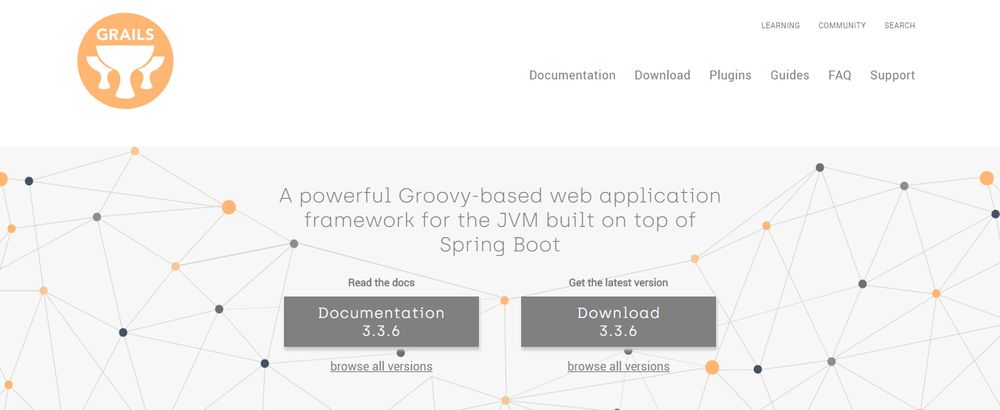
Grails is a web application framework that uses the Groovy programming language. Groovy is an object-oriented language for the Java platform that aims to enhance developer productivity. Its syntax is compatible with Java, and it’s compiled to JVM (Java Virtual Machine) bytecode.
Although you have to write your code in Groovy, Grails works well with other Java-related technologies such as the Java Development Kit, Jakarta EE containers, Hibernate, and Spring. Under the hood, Grails is built on top of Spring Boot to make use of its productivity-friendly features like dependency injection. With Grails, you can achieve the same results with much less code, owing to the power of the Groovy programming language.
Grails follows a handful of modern software development principles such as convention over configuration, opinionated APIs to enforce best practices, and sensible defaults. It’s also very developer-friendly, as it comes with detailed and easy-to-read documentation, step-by-step guides, and an extensive plugin library. You can also build your own plugins and make use of Grails’ IDE support for Eclipse, Sublime, Textmate, IntelliJ IDEA, and other platforms.
Pros:
- built on top of Spring Boot
- seamless integration with Java libraries and tools
- convention over configuration (with sensible defaults)
- async capabilities
- application profiles for React and Angular
- high-quality documentation and tons of learning materials
Cons:
- you need to know Groovy to write Grails apps
GWT: Google Web Toolkit: client-side Java apps deployed as JavaScript
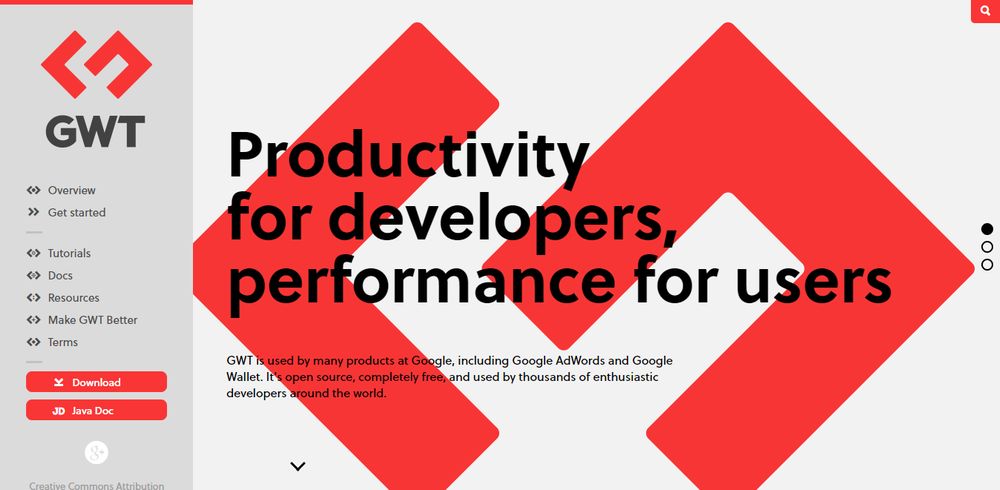
GWT, or the Google Web Toolkit, is a web framework created by Google. You can use it to quickly build Java apps for the web, as it allows you to write client-side Java code and deploy it as JavaScript to the browser.
GWT (pronounced “gwit”) is a stable and well-maintained Java framework. Google uses it in many of its own products, including Google Ads, AdSense, Blogger, and Google Wallet. Google Web Toolkit also has an informative website with tutorials, developer guides, and a starter application.
With GWT, you can build browser-based applications without being an expert in frontend technologies such as JavaScript optimization or responsive design. GWT offers many advanced features such as internationalization, cross-browser portability, UI abstraction, bookmarking, and history management.
Pros:
- handles browser compatibility (including mobile browsers)
- integrated debugging functionality
- code optimization features
- you can unit test your frontend code
- flat learning curve (for Java developers)
Cons:
- no control over the frontend output
- generates non-semantic HTML code
Jakarta Faces (JF): Component-based UI framework
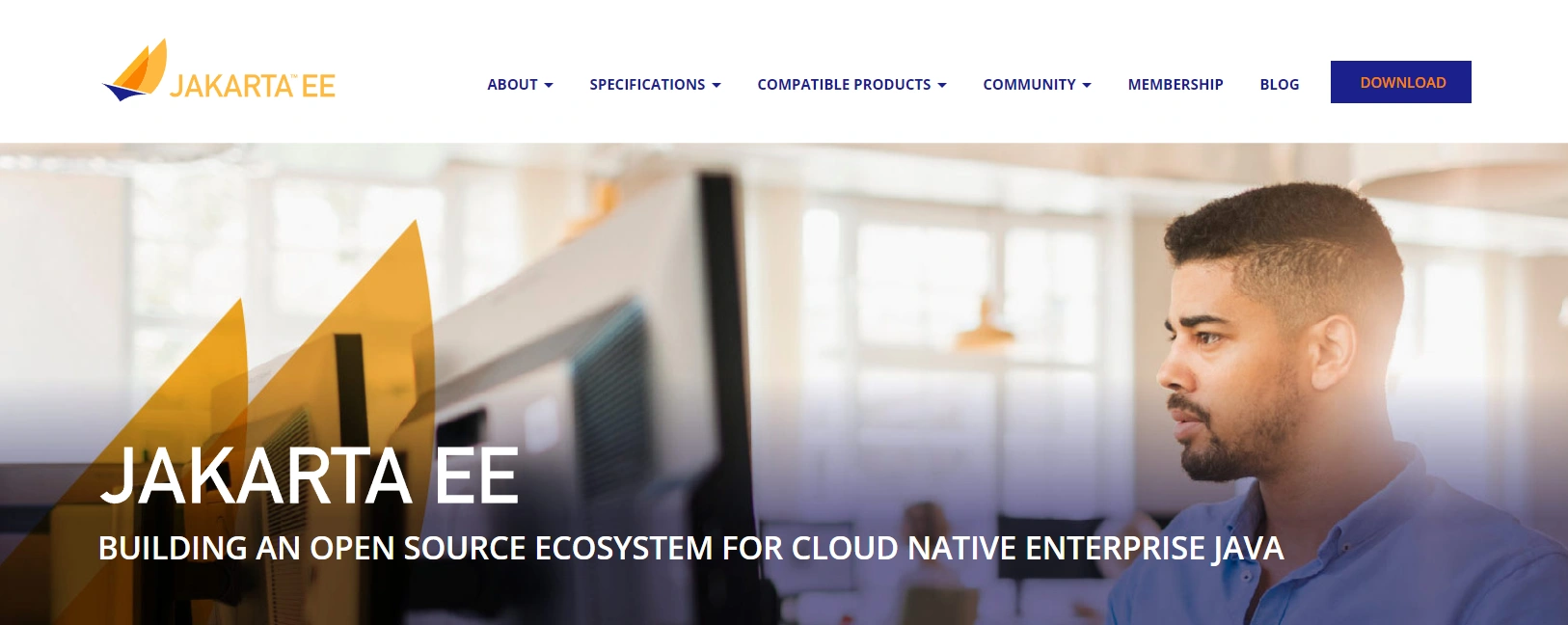
Jakarta Faces, formerly known as JavaServer Faces and later as Jakarta Server Faces (JSF), is a well-established framework for building user interfaces for Java-based web applications. As the first version of Jakarta Faces was released back in 2004, it’s a reliable and stable Java framework.
It follows the MVC software design pattern and has a component-based architecture. With Jakarta Faces, you can build user interfaces consisting of reusable components, manage the state of your components, connect them to data sources, and bind user-generated events to event handlers on the server side.
The default templating system of Jakarta Faces is called Facelets which was created explicitly for this framework. With Facelets, you can use XML instead of Java for view handling. However, you can also create views with other technologies such as XUL (XML User Interface Language) and plain Java. Web applications created with Jakarta Faces are portable across different Jakarta EE application servers.
Note that Jakarta EE (Enterprise Edition) is the open-source version of Java EE — it was rebranded by the Eclipse Foundation in 2018.
Pros:
- reliability (maintained by the Eclipse Foundation)
- built on top of the Servlet API
- cross-browser compatibility
- automatic state management
- supports graceful degradation and multiple output formats
- relatively low learning curve (for Java developers)
Cons:
- hard to debug
- not many tutorials or learning materials
JHipster: Web apps and microservices with Spring Boot and Angular/React/Vue

JHipster brings Spring Boot and popular frontend frameworks (Vue, Angular, React, and others) together in one handy web application generator. It’s used by leading brands such as Adobe, Siemens, Bosch, HBO, and Google. With JHipster, you can quickly create modern Java-based web applications and microservices.
Spring Boot allows you to create production-grade Spring-based applications that work with minimal configuration. JHipster combines this with Angular, React, Vue, and Bootstrap on the client side to provide you with a full-stack architecture. If you want to see how a JHipster app looks in real life, check out the sample apps for Angular, React, and Vue, created by the JHipster team.
JHipster lets you choose between two architectural styles. You can opt for a monolithic architecture where the frontend and backend are combined into a single application. Or, you can go with the microservice architecture that splits the frontend and backend. JHipster also integrates with several tools, and offers a ton of options for client- and server-side coding, bundling, and different DevOps tasks.
Pros:
- significantly speeds up development
- support for many frontend frameworks and technologies
- support for mobile app development (Ionic and React Native)
- built on top of Spring Boot (so you can use dependency injection and other features)
- multiple deployment options
- active community and extensive documentation with sample projects
Cons:
- a huge amount of auto-generated code can be confusing for beginners
MyBatis: Persistence framework for easier SQL management

MyBatis is a persistence framework for Java applications that makes it easier and faster to work with relational (SQL) databases. The framework acts as a middleware between the application and the database and fixes the issues stemming from their different architecture.
You can think of MyBatis as a layer of abstraction between the Java code of your application and the underlying SQL database. By default, you need to use the JDBC (Java Database Connectivity) API to access data sources such as relational databases or spreadsheets from your Java code. MyBatis simplifies this process and lets you interact with relational databases with much less code. For example, you can execute SQL statements with just a single line of Java code.
MyBatis is somewhat similar to the Hibernate framework, as both facilitate communication between the application layer and the database. However, MyBatis doesn’t map Java objects to database tables like Hibernate does — instead, it links Java methods to SQL statements. As a result, SQL is visible when you’re working with the MyBatis framework, and you still have control over the execution of SQL (on the other hand, you’ll need to write your SQL statements and set up your mapping by yourself).
Pros:
- lightweight
- rapid development
- compatible with the Spring framework
- great solution for simple fetches
- portability
- ability to build dynamic SQL queries
- easy to use and learn (for Java developers)
Cons:
- highly dependent on SQL
- hard to debug
- less flexible than Hibernate
Play: Reactive web & mobile framework for highly scalable Java and Scala applications

The Play Framework makes it possible to build lightweight and web-friendly Java and Scala applications for desktop and mobile. Play is a hugely popular framework, used by brands such as LinkedIn, Samsung, Walmart, The Guardian, Verizon, and many others.
Unlike most Java frameworks, it doesn’t rely on Jakarta EE standards. Play is often compared to web frameworks of scripting languages, such as Ruby on Rails for Ruby or Django for Python, as it aims to eliminate the inconveniences of traditional Java web development, such as slow development cycles and too much configuration.
Under the hood, Play is built on top of the Akka toolkit which simplifies the creation of concurrent and distributed applications on the Java Virtual Machine. As a result, Play uses a fully asynchronous model that leads to better scalability.
The Play Framework puts developer productivity first with features such as hot code reloading, convention over configuration, and error messages in the browser. Besides, it’s a Reactive System that follows a modern system architecture (responsive, resilient, elastic, and message-driven) to achieve more flexible and failure-tolerant results.
Pros:
-
lightweight
-
highly scalable
-
asynchronous core
-
supports web technologies (REST, JSON, web sockets, etc.)
-
powerful developer tooling
-
cloud deployment options
-
extensive documentation and active community
Cons:
- issues with backward compatibility (Play 1.x is not compatible with Play 2.x, plus there can be smaller compatibility issues between minor releases of Play 2.x)
PrimeFaces: UI framework for Jakarta EE and Jakarta Faces
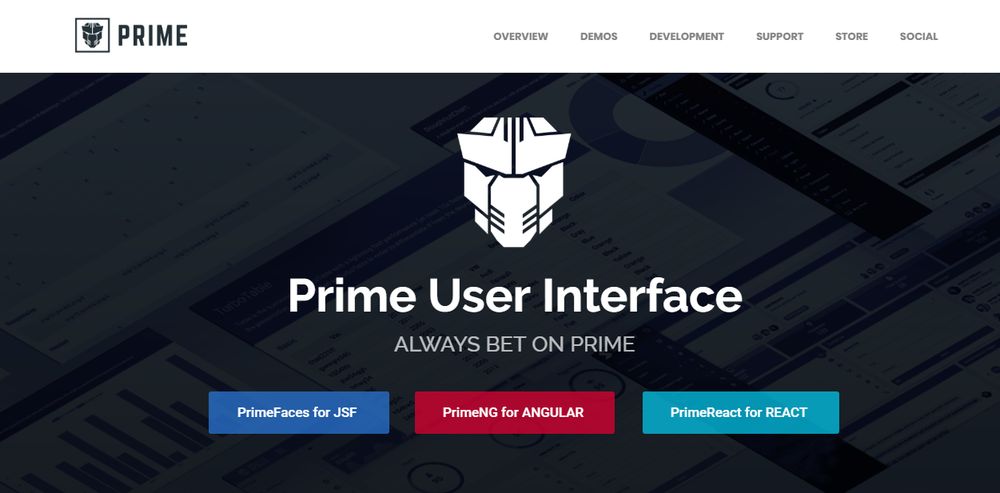
PrimeFaces is a popular web framework for creating lightweight user interfaces for Jakarta EE and Jakarta Faces applications. It’s used by many Fortune 500 companies, government entities, and educational institutions.
The PrimeFaces library is truly lightweight. It’s packaged as a single JAR file, requires zero configuration, and doesn’t have any dependencies. It allows you to create a user interface for your Java application with a rich set of components, a built-in skinning framework, and pre-designed themes and layouts. As PrimeFaces is built on top of Jakarta Faces, it inherits its features such as rapid application development. You can also add the framework to any Java project.
On the PrimeFaces website, you can find an excellent showcase of all PrimeFaces components, templates, and themes. The components come with relevant code snippets you can quickly copy/paste into your app — or tweak them when it’s necessary. For instance, here is a horizontal mega menu that lets you display all submenus of a root item in one group.
PrimeFaces also has a theme designer which is a Sass-based theme engine with more than 500 variables, a sample theme, and font icons. If you don’t want to build a theme yourself, you can also download a community theme or purchase a premium one from the Prime Store.
Pros:
- easy to get started with
- stability (built on top of Jakarta Faces)
- support for mobile functionality (e.g. touch-optimized components)
- ready-made UI components for popular frontend libraries (e.g. PrimeNG for Angular, PrimeReact for React, and PrimeVue for Vue)
- pre-designed frontend layouts and templates (however, not for free — prices start at $19)
- active community
Cons:
- it takes time to master it (you need to know Jakarta Faces to use PrimeFaces)
Spark Framework: Micro framework for web apps and REST APIs
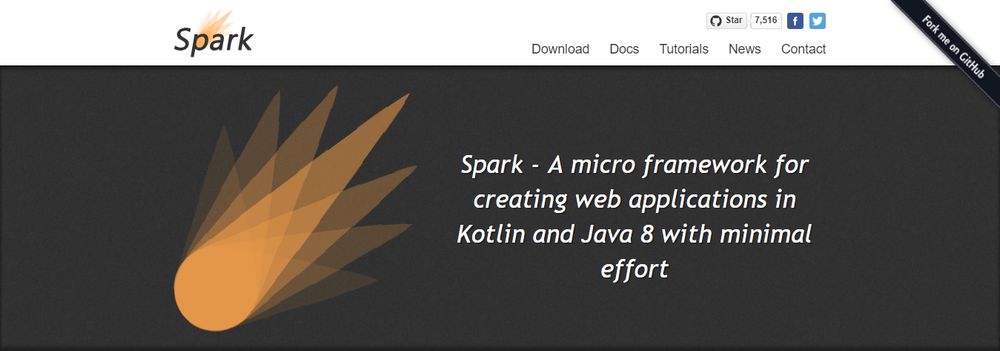
Spark Framework is a micro framework and domain-specific language for the Java and Kotlin programming languages. Kotlin runs on the Java Virtual Machine and is 100% interoperable with Java. Spark helps you with developing Java-based web applications, microservices, and REST APIs.
Micro frameworks first appeared in scripting languages such as Ruby and PHP and quickly gained traction due to their focus on development speed and simplicity. Spark was inspired by the Sinatra web application framework for Ruby. It was first released in 2011. It’s not an MVC framework — instead, it lets you structure your app the way you want. Like most micro frameworks, Spark has a small code base, needs minimal configuration, and doesn’t require you to write a lot of boilerplate code.
You can get the Spark Framework up and running in just a few minutes. By default, it runs on the Jetty web server that is embedded into the framework. However, you can use it with other Java web servers as well. According to Spark’s own survey, more than 50% of their users used the framework to create REST APIs, which is its most popular use case. Spark also powers high-traffic web applications serving more than 10,000 users a day.
Note that the Spark Framework is not the same thing as Apache Spark, which is an analytics engine for big data processing.
Pros:
- lightweight
- allows for rapid development
- requires little boilerplate code
- declarative and expressive syntax
- unopinionated (you can structure your app as you want)
Cons:
- development is less active recently
- not many tutorials or learning materials
Tapestry: Component-oriented framework for highly scalable apps

Tapestry is a component-based Java framework with which you can create scalable web applications. Its focus on reusable components makes it architecturally similar to Jakarta Faces and Apache Wicket (see both above). Like Struts and Wicket, Tapestry is also a project of the Apache Software Foundation.
You can write Tapestry pages and components as plain old Java objects (POJOs), so you can access the entire Java ecosystem from the framework. Besides Java, Tapestry also supports the Groovy and Scala programming languages and integrates with other Java frameworks such as Hibernate and Spring. Tapestry has been built with performance in mind; therefore it provides you with features such as live class reloading, exception reporting, Ajax support, and built-in components and templates.
Tapestry is a developer-friendly framework as well. It has built-in utilities to facilitate test-driven development (TDD) and comes with support for the Selenium testing framework. Tapestry scales nicely both on single servers and server clusters. Apps built with Tapestry run fast in the browser, as it follows best practices such as client-side caching, support for concurrent threads, JavaScript aggregation and compression, integrated Gzip compression, and more.
Pros:
- scalable
- straightforward testing
- convention over configuration
- components are pure Java objects
- comes with premade components
- great exception reporting
Cons:
- hard to find tutorials and learning materials
Vaadin: Web application framework with a focus on UX, accessibility, and mobile
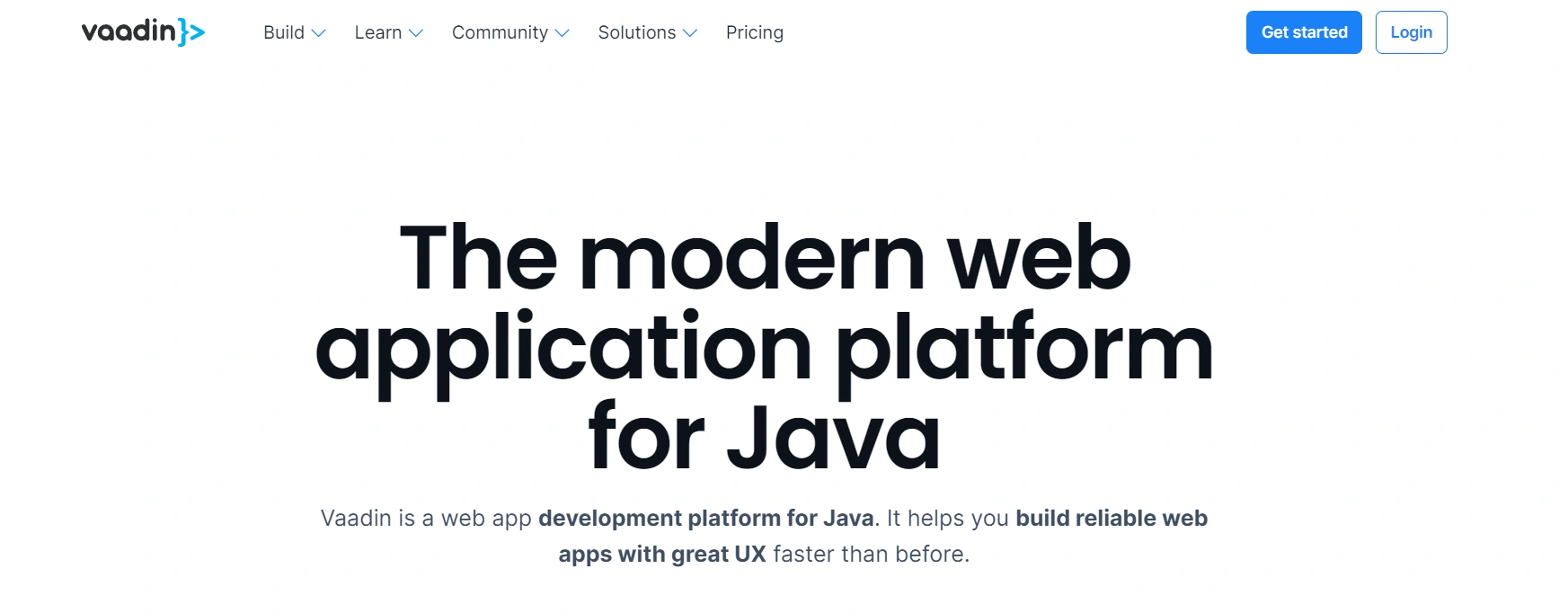
Vaadin provides a platform for streamlined Java development. It allows you to build web applications from customizable components that focus on performance, user experience (UX), and accessibility.
Vaadin 10+ approaches web app development in a new way: it gives developers direct access to the DOM (Document Object Model) from the Java Virtual Machine. With the new release, the Vaadin team split the previously monolithic framework into two parts. It has a lightweight Java framework called Vaadin Flow that handles routing and server-client communication and a set of UI components that run in the user’s browser.
The components are Web Components and mobile-first and follow the latest web and accessibility standards. You can use Vaadin components together with any frontend framework such as React, Angular, or Vue. You can build your own theme based on Vaadin components or use Vaadin’s two premade themes: Lumo (default) and Material.
Vaadin Flow provides a high-level Java API to manage all the technical aspects of your app, from automatic server-client communication to WebSockets to data binding. As Flow runs on the JVM, you have access to the whole Java ecosystem, for instance, you can run your app with the Spring Boot. Flow also lets you write your app in Kotlin or Scala.
Pros:
- uses a unique programming architecture
- follows web standards
- mobile-friendly components
- extensible (see the Vaadin Add-on Directory)
- seamlessly integrates with the Spring Framework
- premade themes for Java apps (available for free)
Cons:
- Vaadin is a for-profit company, so you’ll have to pay for Pro components, tools, and support (see pricing).
Vert.x: Polyglot event-driven application framework for the Java Virtual Machine
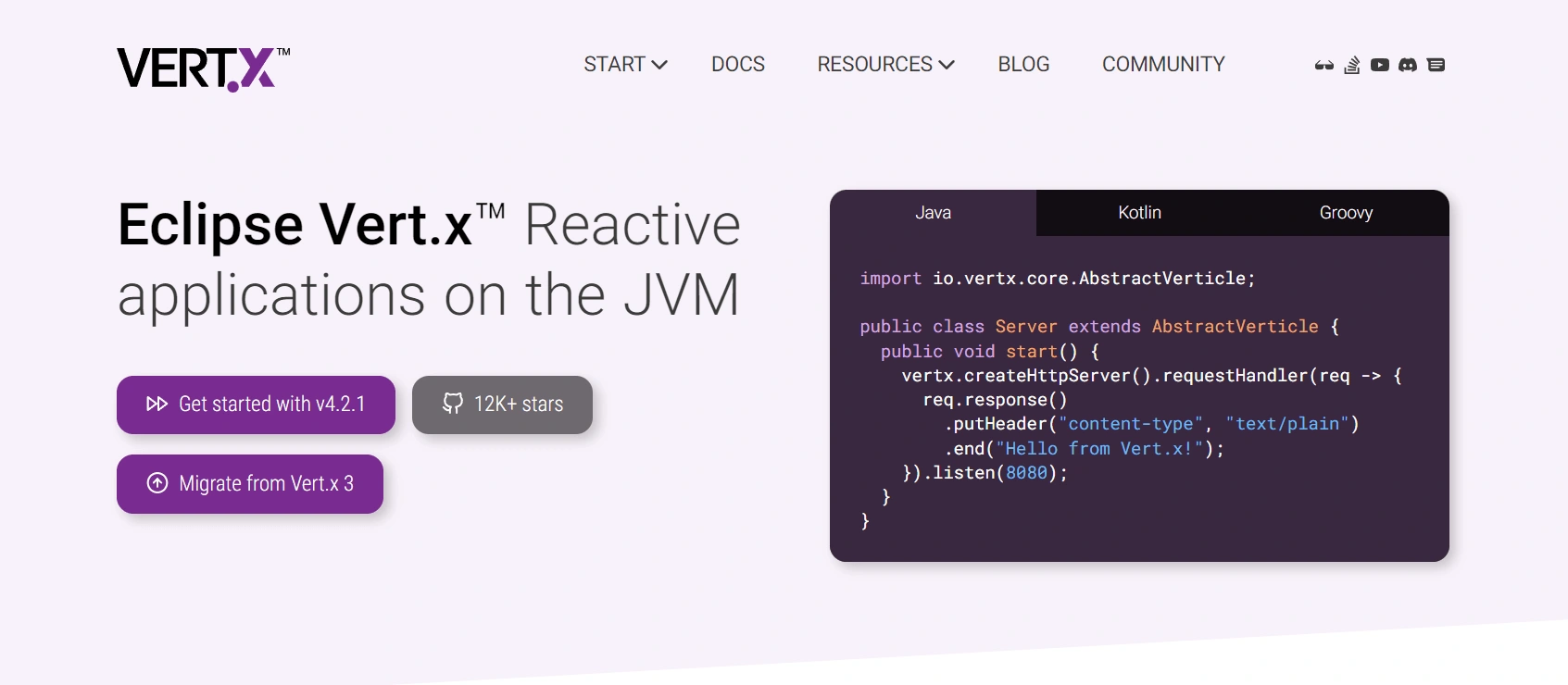
Vert.x is a polyglot framework running on the Java Virtual Machine. It allows you to write apps in programming languages such as Java, JavaScript, Groovy, Ruby, Scala, and Kotlin. Its event-driven architecture results in applications that scale nicely even with minimal hardware resources.
Vert.x is developed and maintained by the Eclipse Foundation. The ‘x’ in Vert.x refers to its polyglottic nature, meaning that you can write valid code in several different languages. It provides idiomatic APIs for every supported programming language.
As Vert.x is an event-driven and non-blocking framework, it can handle a lot of concurrencies using only a minimal number of threads. Vert.x is also quite lightweight, with the core framework weighing only about 650 KB. It has a modular architecture that allows you to use only the modules you need so that your app can stay as slick as possible. Vert.x is an ideal choice if you want to build lightweight, highly scalable microservices.
Pros:
- loads fast
- modular architecture
- extensible
- unopinionated (you can structure your application as you want)
- easy-to-use app generator
- extensive documentation
Cons:
- steep learning curve (more of an advanced toolkit than a framework, so you need to make a lot of decisions on your own)
Next steps
That’s a wrap on our Java framework comparison. As each of these frameworks serves different purposes, understanding their pros, cons, and capabilities is essential before choosing one or more for your particular Java project.
To pick the best Java framework for your application, you’ll need to take into account your goals, your budget, and the knowledge of your team, among other factors.
Once you’ve chosen your framework, always read the docs. Once your app is up and running, don’t forget about monitoring and catching errors in real time. Raygun Crash Reporting and Error Monitoring is easily available with Raygun4java, a library that you can easily add to your Java application, which will then allow you to view all exceptions on your Raygun dashboard. Installation is painless, and configuring your site to transmit errors takes only 5 minutes. Sign up for a free 14-day trial.



